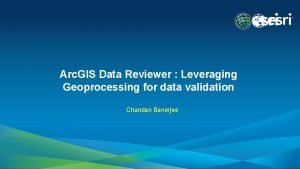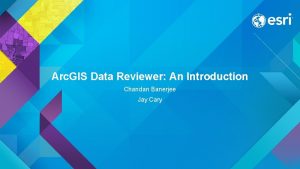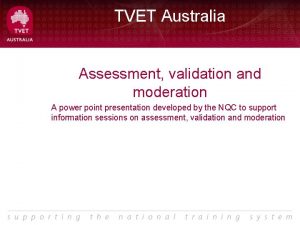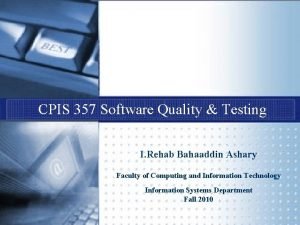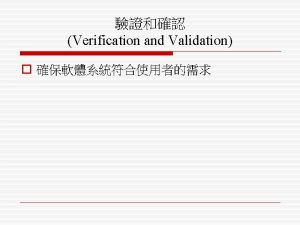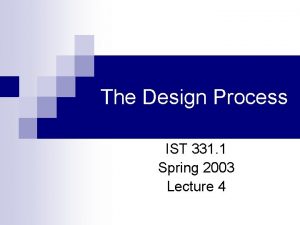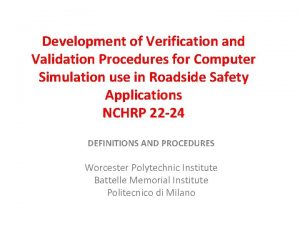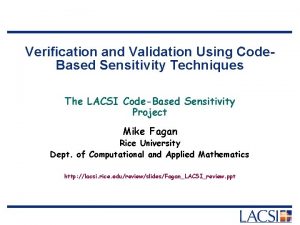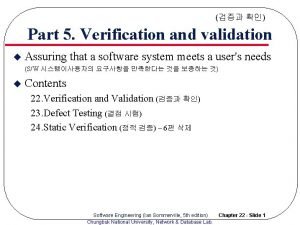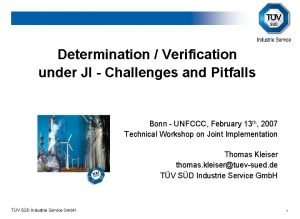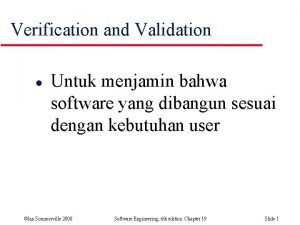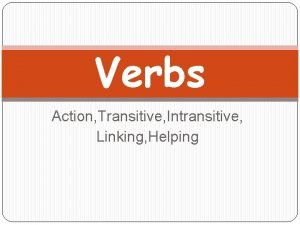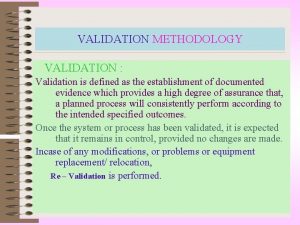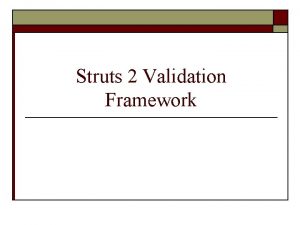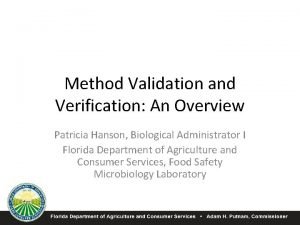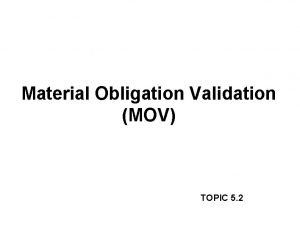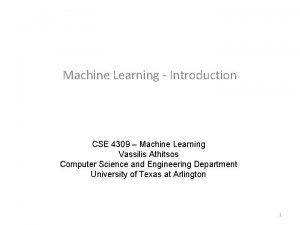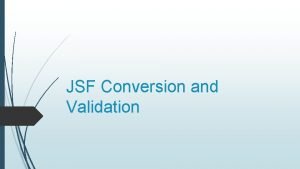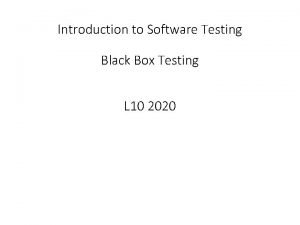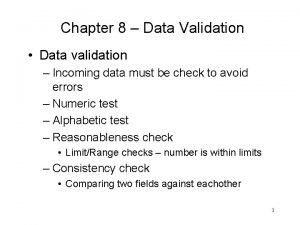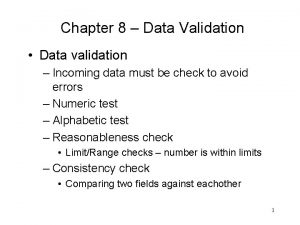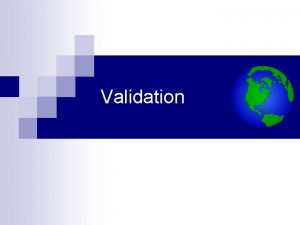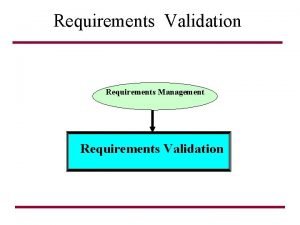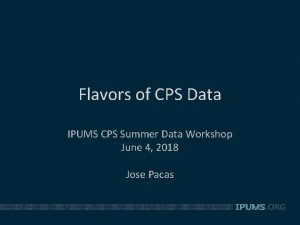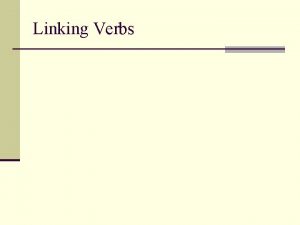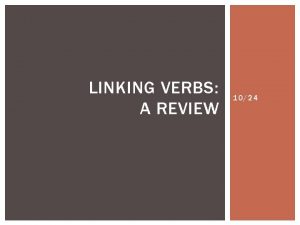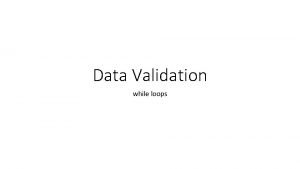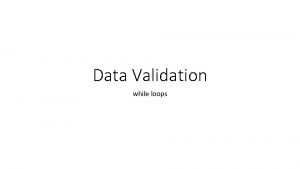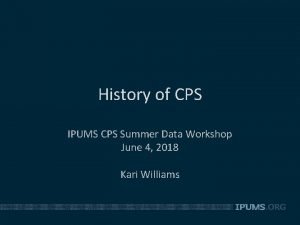CPS Linking Validation Linking CPS Data Opportunities and




































- Slides: 36

CPS Linking & Validation

Linking CPS Data Opportunities and Challenges

Opportunities • Large sample sizes • Good coverage of subpopulations • Short-run changes in employment and families; reactions to births and losses (death, divorce) • Combine rich sources of information about different topics • Work and volunteering; veterans and employment

Same Month One Year Apart • Useful for studying year-to-year change • Earnings and employment dynamics, • Geographic mobility, • Movement into and out of labor unions • For the 1994 -forward period, researchers can expect: March 1994 -1995 March 2009 -2010 Linked N 48, 140 53, 486 Retention Rate 69. 4% 78. 8%

Single Cohort, All 8 Months • Useful for studying short-term dynamics • Change in economic arrangements as a function of social and demographic characteristics • Changes in these relationships over time • For the 1994 -forward period, researchers can expect: Cohort Entering January 1994 Cohort Entering January 2009 Linked N 10, 069 11, 528 Retention Rate 59. 7% 68. 0%

Challenges • Rotation pattern • Linking keys • Same variables with different codes • Non-response • Another layer of complexity if ASEC is part of design • Data management

Challenges: Rotation Pattern • CPS is NOT a longitudinal survey that follows one or several cohorts as they age • CPS does have a panel component where individuals are observed up to 8 times over 16 months, but the way they move through the survey is in a 4 -8 -4 rotation

Challenges: Rotation Pattern • Enter IPUMS CPS Ro. PES • Motivation • Easily see CPS rotation pattern • Explore what topical supplements can be examined together • Name it!

Challenges • Rotation pattern • Linking keys • Same variables with different codes • Non-response • Another layer of complexity if ASEC is part of design • Data management

Challenges: Linking Keys • Changes in variables needed to link • Duplicate and recycled identifiers • Feng 2001 • Suppressed in some years

Challenges: Linking Keys January 1989 to December 1993 January 1994 to April 2004 May 2004 + HRHHID PULINENO STATEFIPS HUHHNUM HRSAMPLE HRHHID 2 HRSERSUF **Transformations detailed in Drew, Flood & Warren 2014

Challenges: Linking Keys • CPSID(P) – an IPUMS-created unique identifier • Bridges changes in variable names as well as the technical aspects of how to link • Unique for 1976 forward • Identifies “mechanical” matches • Drew, Flood, & Warren, 2014 Journal of Economic and Social Measurement

CPSID(P) Limitations • Mechanical • Created solely based on linking keys • Does NOT condition on AGE, SEX, RACE • Linking keys should work, but it is always good to check

CPSID(P) Limitations • Not available for all respondents in ASEC…only those who are also in the March Basic • 1970 s and 1980 s issues • Some files can’t link • 1977 supplements and basics • Duplicate identifiers (1976 -1983) • Duplicates *never* link to adjacent months in CPSID • Children are in some supplements but not basics • In these years, children never link

Future Linking Work • ASEC to pull in oversamples • A version of CPSIDP conditional on AGE, SEX, RACE matches

Challenges • Rotation pattern • Linking keys • Same variables with different codes • Non-response • Another layer of complexity if ASEC is part of design • Data management

Challenges: Same variables, different codes • IPUMS! • Harmonized across time to deal with changes in codes • Use it for good, never for evil!

Challenges • Rotation pattern • Linking keys • Same variables with different codes • Non-response • Another layer of complexity if ASEC is part of design • Data management

Challenges: Non-response • Households that were eligible to participate in CPS but did not because of non-response, death, migration • Be careful! • Make sure you’re linking what you think you’re linking • Double check MIS combinations • Look at merge results • Imputation

Challenges • Rotation pattern • Linking keys • Same variables with different codes • Non-response • Another layer of complexity if ASEC is part of design • Data management

Challenges: ASEC • Differently named variables, including linking keys, than basic monthly • MARBASECID (1989+) • Variable to link ASEC and March basic monthly • Allows us to put CPSIDP on ASEC • Flood & Pacas 2017 Journal of Economic and Social Measurement • Reference periods

Challenges • Rotation pattern • Linking keys • Same variables with different codes • Non-response • Another layer of complexity if ASEC is part of design • Data management

Challenges: Data Management • Can quickly find yourself managing a large number of files if you’re: • Not using IPUMS • Performing merges for linking • Strategies for dealing with this include: • Loops • Temporary files • Long data format

Challenges • Rotation pattern • Linking keys • Same variables with different codes • Non-response • Another layer of complexity if ASEC is part of design • Data management

Validation Approaches, Our Assumptions, and a Note on Data Structure

Validation: Approaches • Because CPSIDP is mechanical, this is a step we recommend you do if you are linking CPS data across months • No right or wrong way to do this, but there a couple approaches in the literature 1. Use AGE, SEX, RACE (Madrian & Lefgren) 2. Incorporate DQ flags 3. Use Bayesian approach (Feng) • Argues that some people are lost with first approach; this yields higher linkage rates

Validation: AGE, SEX, RACE Rules • AGE • If the interviews you are linking are both in MIS 1 -4 or MIS 5 -8, difference between AGE at two time points is 0 or 1 • If the interviews you are linking come from both MIS 1 -4 and MIS 5 -8, difference between AGE at two time points is 0, 1, or 2 • Beware of AGE codes 80 and 85! Allow for a greater AGE increase. Age 80=80 -84. Age 85=85+. • SEX & RACE • No change allowed

Validation: Age Rules MIS AGE 1 2 3 4 5 6 7 8 18 19 19 20 20 50 50 51 51 79 79 79 80 80 80 84 80 80 85 85 85 Can age 0 or 1 years compared to MIS 1 Can age 0 or 5 years compared to MIS 1 Can age 1 or 2 years compared to MIS 1 Can age 0 or 5 years compared to MIS 1

Validation: Our Assumptions • For however many observations you are linking • SEX and RACE may not change • AGE may only change in expected ways • Changes in AGE are always compared to the first time point being linked

Validation: Our Assumptions • AGE, SEX, and RACE must ALL match in expected ways – GOOD! MISH Six Seven Eight AGE 21 21 21 SEX Female RACE White

Validation: Our Assumptions • AGE, SEX, and RACE must ALL match in expected ways – BAD! MISH Six Seven Eight AGE 21 21 21 SEX Female RACE White Asian only White

Validation: Data Structure • Validation gets complicated quickly • We want you to try to write validation code in the lab to think through validation • We will provide validation code for you based on our all or nothing assumptions about AGE, SEX, and RACE for data in both • Long format • Wide format

Validation: Long Format • For each individual • # records = # times observed MISH 1 2 3 AGE 21 21 21 SEX Female RACE White

Validation: Wide Format • For each individual • # records = 1 regardless of # times observed AGE SEX RACE 1 2 3 21 21 21 Fem Fem White

Long to Wide Format Data Long MISH 1 2 3 AGE 21 21 21 SEX Female RACE White Wide AGE SEX RACE 1 2 3 21 21 21 Fem Fem White

Questions?
 Dynamic picture
Dynamic picture Gis data validation
Gis data validation Gis data validation
Gis data validation Validation checks ict
Validation checks ict Data validation software
Data validation software Validation and moderation
Validation and moderation Verification and validation
Verification and validation Verification and validation
Verification and validation Verification and validation
Verification and validation V model verification and validation
V model verification and validation Ist spring design and validation
Ist spring design and validation Verification and validation
Verification and validation Validation and calibration of master plan
Validation and calibration of master plan Verification and validation
Verification and validation Verification and validation
Verification and validation Pega express
Pega express Verification and validation plan
Verification and validation plan Verification and validation
Verification and validation A nested model for visualization design and validation
A nested model for visualization design and validation A software verification and validation method. section 19
A software verification and validation method. section 19 Software verification and validation plan
Software verification and validation plan Challenges
Challenges Linking verbs
Linking verbs Akamai xss bypass
Akamai xss bypass Is unit testing verification or validation
Is unit testing verification or validation Validationrule wpf
Validationrule wpf Types of process validation
Types of process validation Twic compliant identification management system
Twic compliant identification management system Validation in struts2
Validation in struts2 Process validation report
Process validation report Java for xbrl validation tool
Java for xbrl validation tool Method verification vs validation
Method verification vs validation Method verification vs validation
Method verification vs validation Material obligation validation
Material obligation validation Why we use validation set
Why we use validation set Jsf number converter
Jsf number converter Black box and white box testing
Black box and white box testing

